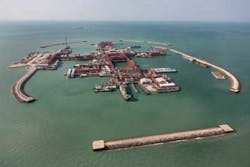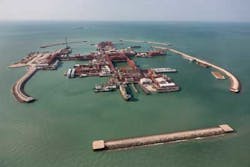Kazakhstan consortium achieves first oil from Kashagan field
Bruce Beaubouef
Managing Editor
In September, the North Caspian Operating Co. (NCOC), led by Eni, officially tapped the super-giant offshore oilfield, Kashagan, in the Kazakhstan sector of the Caspian Sea. Located some 80 km (49.7 mi) southeast of Atyrau, Kashagan is the largest oil accumulation in the North Caspian Sea with estimated oil in place of around 35 Bbbl.
Future phases of development could significantly increase production volumes. It is Kazakhstan's first offshore oil development, and has an estimated 13 Bbbl of proved and recoverable reserves. Named after a 19th century Kazakh poet from Mangistau, Kashagan is the largest oil field to be discovered in the past 35 years.
For context, the 13 Bbbl of recoverable reserves represents most of Kazakhstan's offshore proved oil reserves, and is roughly equivalent to Brazil's entire proved oil reserves, both onshore and offshore, according to the US Energy Administration.
The recent start of the first of the 40 wells in the initial phase of production comes eight years later than originally anticipated. Since the field's discovery in 2000, the consortium has invested more than $40 billion in the project, making Kashagan not only the largest oilfield outside the Middle East, but also one of the world's most expensive.
Perhaps even more impressive is the complexity of the project. The Kashagan reservoir is about 14,000 ft (4.267 m) below the seabed with high pressure (770 bar/1,168 psi initially); elevated levels of hydrogen sulfide (15% H2S); and some carbon dioxide (4% CO2) in shallow, ice-prone water.
This part of the North Caspian is extremely shallow (average depth: 3.3 m/11 ft) and is subject to weather extremes: violent storms in summer and winter temperatures as low as -40°C. There are also significant fluctuations in water level and heavy drift ice during the winter months. Ice build-up is exacerbated through the combination of shallow water, low salinity, and low temperatures.
These conditions eliminated the feasibility of traditional drilling and production facilities, such as concrete structures or jacket platforms that rest on the seabed. Instead, the consortium opted for a series of artificial islands to host the drilling and production equipment.
There are two main types of island - small unmanned drilling islands and larger manned hub islands. Hydrocarbons travel from the drilling islands to the hub islands via pipeline. The hub islands contain processing facilities to separate recovered liquid (oil and water) from the raw gas, as well as gas injection and power generation systems.
During Phase I, around half of the gas produced will be re-injected into the reservoir. Separated liquid and raw gas will be taken by a dual, 57-mi (92-km) pipeline system to the Bolashak onshore processing plant in Atyrau oblast, where export quality oil will be produced. Some of the processed gas will be sent back offshore for use in power generation while some will be used to generate power at the process plant itself.
Production from the initial phase of development will reach 180,000 b/d of oil and then rise to the full Phase 1 target of 370,000 b/d. A possible second phase would boost production to 1.5 MMb/d. However, the partners will need to determine if they will be able to recoup their expenses and reach an acceptable level of profitability before the project's production-sharing agreement terminates in 2041.
Agip KCO awarded a $155-million contract for construction of elements of the Kashagan production facilities to the Boskalis/Archirodon joint venture in early 2003. Almost 4 million metric tons (4.4 million tons) of rock was required for the construction of the island group and its ice barriers.
The scope of work for the islands included the construction of four outer main ice barriers, three inner ice barriers, the riser island (including flare extension) and three pipe rack cofferdams. The cofferdams, with a total length of 715 m, each consist of two sheet pile walls, between which quarry run was placed.
NCOC acts on behalf of seven co-venture consortium partners as operator, appraising and developing the hydrocarbon assets of 11 offshore blocks under the North Caspian production-sharing agreement. Their equity interests are: KazMunayGas 16.81%, Eni 16.81%, ExxonMobil 16.81%, Shell 16.81%, Total 16.81%, ConocoPhillips 8.40%, and INPEX 7.56%. Recently, ConocoPhillips sold its interest in the project to KazMunayGas for approximately $5.4 billion.
Major contractors and service suppliers for the Kashagan project included:
Boskalis/Archirodon. Built the complex of rock islands in 4-m water depth at a location some 75 mi offshore
CB&I, WorleyParsons, and Aker Solutions joint venture. Updated front-end engineering and design services contract for Phase 2 of the full-field development
GE Oil & Gas. Two ultra-high-pressure, barge-mounted, sour gas reinjection trains
Cybernetix. Suite of subsea temperature monitoring systems for installation on the multi-phase pipelines, as part of the hydrate prevention and management program
Saipem. Fabrication, assembly, transport. and installation of the flares and piles sustaining the offshore structures, as well as installation of 14 module barges. The scope includes procurement, fabrication and connection of associated mooring, protection, and interconnecting structures
Aker Kvaerner/Ersai. Hook-up and commissioning of the offshore facilities plus inshore completion
Tracerco. Profiler separator level control instrument for the offshore D test separator.
About the Author
Bruce Beaubouef
Managing Editor
Bruce Beaubouef is Managing Editor for Offshore magazine. In that capacity, he plans and oversees content for the magazine; writes features on technologies and trends for the magazine; writes news updates for the website; creates and moderates topical webinars; and creates videos that focus on offshore oil and gas and renewable energies. Beaubouef has been in the oil and gas trade media for 25 years, starting out as Editor of Hart’s Pipeline Digest in 1998. From there, he went on to serve as Associate Editor for Pipe Line and Gas Industry for Gulf Publishing for four years before rejoining Hart Publications as Editor of PipeLine and Gas Technology in 2003. He joined Offshore magazine as Managing Editor in 2010, at that time owned by PennWell Corp. Beaubouef earned his Ph.D. at the University of Houston in 1997, and his dissertation was published in book form by Texas A&M University Press in September 2007 as The Strategic Petroleum Reserve: U.S. Energy Security and Oil Politics, 1975-2005.


